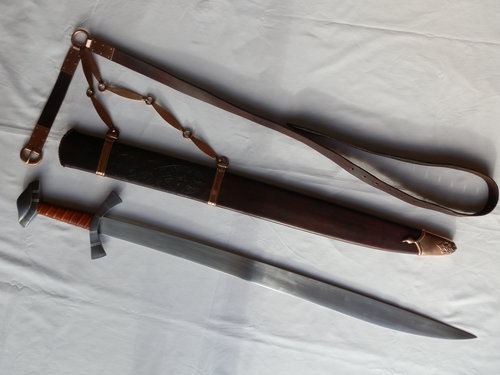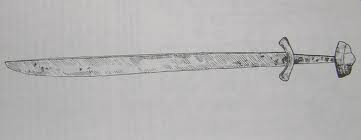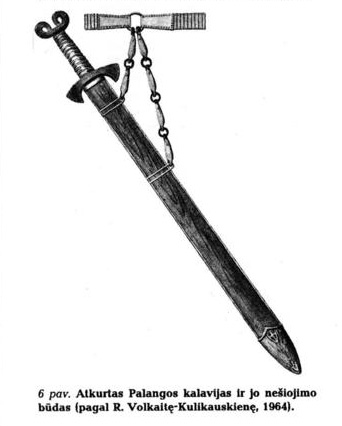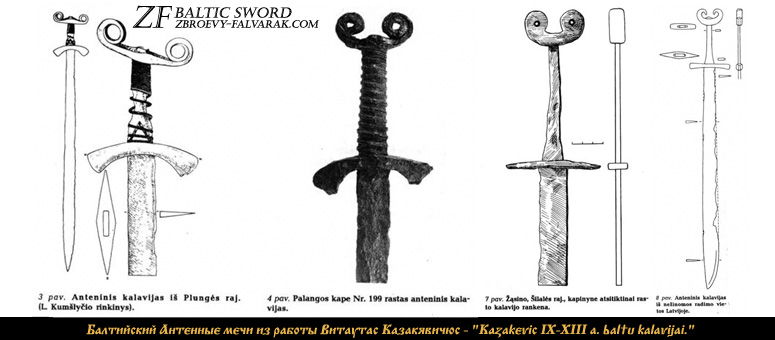Posts: 111
Thu 23 Sep, 2021 3:31 pm
Any migration/viking curved swords?
Good day,
Anyone know if any curved migration/viking swords like Jeff Helmes Baltic Viking Sword we’re available then?
Best regards,
Barrett Hiebert
 Attachment: 38.6 KB
Attachment: 38.6 KB

Posts: 355 Location: Höör, Skane
Fri 24 Sep, 2021 11:23 am
I would not consider that sword curved rather its single edged.
The shape of that repro it's a bit off from any archeological example I have seen, but I have probalby not seem them all..
All examples I know of from scandinavia are straight single edge, and not curved. (Petersen type 14, seem to be most popular in Norway)
Posts: 506 Location: NC
Sat 25 Sep, 2021 11:19 am
I recently read that single edged viking and migration period swords are a lot more common that first thought. I dont remember the article though unfortunately.
As to curved, I have never seen an example of that
Posts: 315 Location: YORKSHIRE, UK
Sat 25 Sep, 2021 11:55 pm
We did have this recent find mentioned at the beginning of the month elsewhere on the forum
[ Linked Image ]
Described as Scandinavian type, with a hint of a curve. Apparently from a battle fought on the site in 1091, so at the later end of the time range.
Posts: 1,717 Location: Buffalo, NY.
Sun 26 Sep, 2021 7:50 am
That’s a really interesting artifact. It would be nice to have a better shot of it. I wonder if the curve has happened with time or is original.
I wonder how long it is.
Posts: 315 Location: YORKSHIRE, UK
Sun 26 Sep, 2021 8:21 am
| Jeremy V. Krause wrote: |
That’s a really interesting artifact. It would be nice to have a better shot of it. I wonder if the curve has happened with time or is original.
I wonder how long it is. |
The original article is here :
https://scienceinpoland.pap.pl/en/news/news%2C88972%2Crare-scandinavian-combat-knife-found-poland.html
It does have a second picture but not as clear. As to size, the archaeologists scales are in centimetres - that is a decimetre scale to the right.
Posts: 1,717 Location: Buffalo, NY.
Sun 26 Sep, 2021 8:36 am
It's a bit confusing. They bring up the battle fought in 1091 but then state that the blade is of "early Viking" origin dating it to the 8th. C.
It really doesn't look like an 11th. C. specimen so that makes more sense.
Posts: 111 Location: Nebraska
Mon 27 Sep, 2021 1:33 pm
| Jeremy V. Krause wrote: |
It's a bit confusing. They bring up the battle fought in 1091 but then state that the blade is of "early Viking" origin dating it to the 8th. C.
It really doesn't look like an 11th. C. specimen so that makes more sense. |
I suppose it could have been made earlier and still have been used in a later battle. Sword passed down but finally dropped at that battle?
Posts: 496 Location: Poland
Tue 28 Sep, 2021 1:40 am
The articles I can find aren't very clear, but one in "Nauka w Polsce" clearly says it was loose find, kinda random and cannot be dated because was found with no context.
So it doesn't seem anyone connects it to the battle of 1091, it was just found during excavations that were aimed at locating the battlefield mentioned in chronicle.
It's apparently cautiously dated to the 8th century indeed, based on analogy from Haukeli.
Posts: 1,606 Location: Chicago, Illinois
Wed 29 Sep, 2021 5:40 pm
Re: Any migration/viking curved swords?
| Barrett Hiebert wrote: |
Good day,
Anyone know if any curved migration/viking swords like Jeff Helmes Baltic Viking Sword we’re available then?
Best regards,
Barrett Hiebert |
This sword was a reproduction of a sword type that was typical to the eastern Baltic region, specifically Latvia, Estonia, and Lithuania. They are from the very late Viking or early medieval age, definitely not migration period. The sword type often featured a gentle curve, or a "belly" which gave the appearance of a curve. This repro is very historically accurate, so yes, they were available.
| Bjorn Hagstrom wrote: |
The shape of that repro it's a bit off from any archeological example I have seen, but I have probably not seem them all..
All examples I know of from Scandinavia are straight single edge, and not curved. (Petersen type 14, seem to be most popular in Norway) |
As I said above, swords like these were typical, but not in Scandinavia. Many of the most celebrated (and most interesting) swords from the Viking age were not Scandinavian and don't fit neatly into Petersen's typology, which is based on mostly Norwegian examples. Eastern examples such as these really drive that point home. Some of the Continental swords of the era are amazing and also don't fit into Petersen's typology. The same is very true for Anglo Saxon examples. Petersen is a good reference, but he's only 1 reference whose scope is pretty narrow....
I've attached a drawing of the original that this sword was a reproduction of, and several other examples of the type to give you a frame of reference. Notice that most are curved, or feature the "belly" that I mentioned above. The hilt style was usually a Petersen type Z or the antennae style, which was likely a local interpretation of the contemporary Petersen AE.
 Attachment: 3.33 KB
Attachment: 3.33 KB

 Attachment: 24.67 KB
Attachment: 24.67 KB

 Attachment: 67.71 KB
Attachment: 67.71 KB

 Attachment: 60.27 KB
Attachment: 60.27 KB
[ Download ]
You
cannot post new topics in this forum
You
cannot reply to topics in this forum
You
cannot edit your posts in this forum
You
cannot delete your posts in this forum
You
cannot vote in polls in this forum
You
cannot attach files in this forum
You
can download files in this forum




